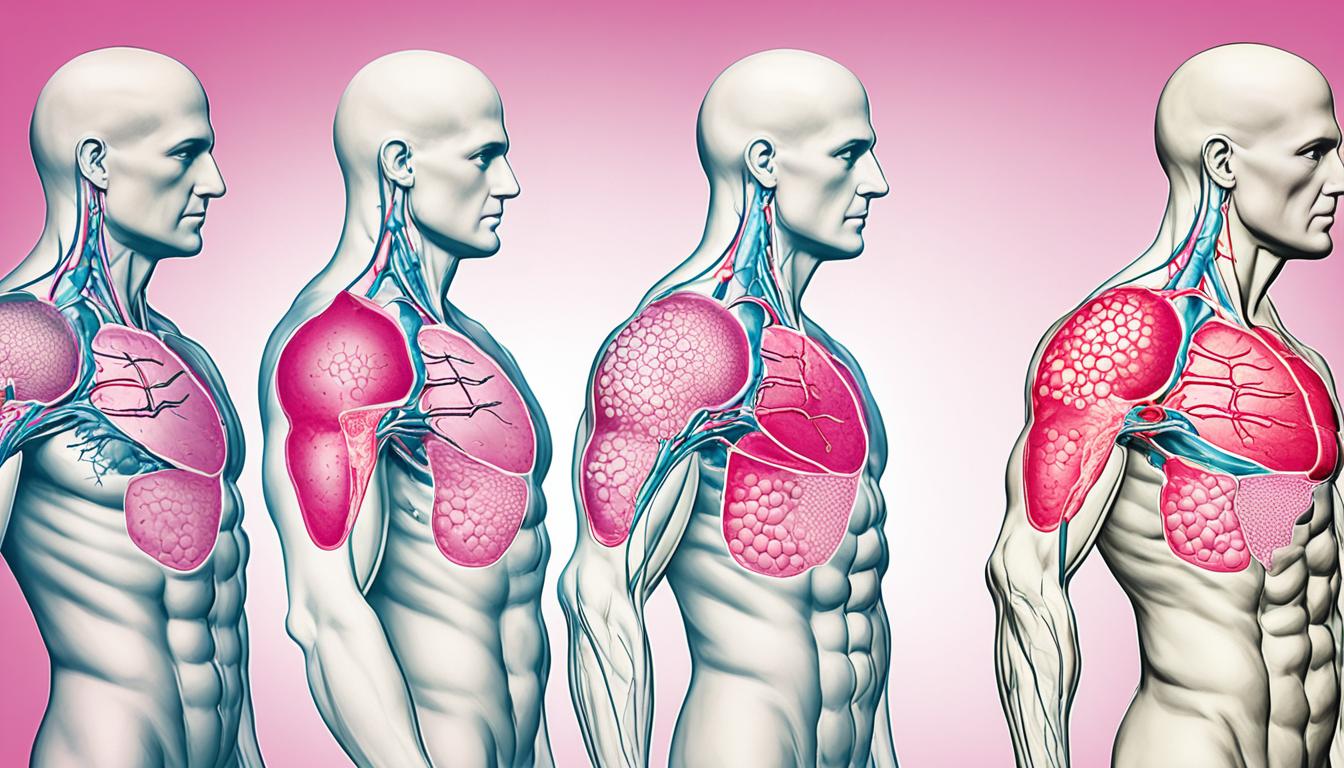Men don’t have as much breast tissue as women do. But they can still get breast cancer, though it’s very rare. Also, the chance of a man getting breast cancer in his life is about 1 per 1,000.
If men have breast cancer, it’s often found later than in women. They might notice changes in their chest but not think it’s a big deal. Typically, men get breast cancer between ages 60 and 70.
Things like family history, radiation to the chest, and enlarged breasts can raise the risk. Other risk factors include taking estrogen, certain genetic conditions, and some health issues.
The symptoms of breast cancer in men are like those in women. The main sign is usually a lump in the chest. Men need to have physical exams, mammograms, and biopsies to check for this cancer.
Treatments for male breast cancer are like those for women. This includes surgery, radiation, and chemotherapy. Hormone therapy and targeted drugs are also used. It’s really important for men with breast cancer to see their doctor regularly after treatment.
Key Takeaways:
- Breast cancer can occur in men, although it is rare.
- Men should be aware of changes in their breast tissue and seek medical attention if they notice any symptoms.
- Risk factors for male breast cancer include a family history of breast cancer, radiation exposure, enlarged breasts, and certain medical conditions.
- Early detection is crucial for effective treatment, and men should undergo the same diagnostic tests as women.
- Treatment options for male breast cancer may include surgery, radiation therapy, chemotherapy, hormone therapy, and targeted therapy.
Diagnosis and Treatment of Male Accessory Breast Cancer
Accessory breast cancer is very rare in men. It happens even less often than breast cancer does in men. Because of this, we don’t know a lot about how to diagnose and treat it.
The main way to treat this cancer is to remove the affected breast tissue. This means surgery. After surgery, other treatments like chemotherapy and radiotherapy may be used. These treatments help lower the chances of the cancer coming back.
Men diagnosed with this form of cancer are usually around 67 years old. But, some have been diagnosed as young as in their 40s. Symptoms often include pain, red or purple skin, swelling, and fluid coming from the area.
Because male accessory breast cancer is so uncommon, we need more research. This way, we can learn how to diagnose and treat it better. We also need to understand what the long-term effects are for the patients.
Systematic Review of Male Accessory Breast Cancer
A deep look at the current research on male accessory breast cancer can tell us a lot. It can tell us how often it happens, what it looks like, and how treatments work. But, not many studies have been done because it’s so rare.
However, looking at all these few studies can show us important trends. It can point out things like common symptoms and risks. This can guide future research efforts.
| Research Outcomes | Key Findings |
|---|---|
| Incidence of Male Accessory Breast Cancer | Extremely rare, accounting for a small fraction of male breast cancer cases. |
| Age of Onset | Most commonly diagnosed in older male individuals, with the average age of 67.1 years. |
| Clinical Characteristics | Pain, reddish or purplish skin covering the mass, swelling and erosion on the surface, purulent exudate. |
| Treatment Approaches | Primary surgical resection followed by comprehensive treatment including chemotherapy, radiotherapy, and endocrine therapy. |
While systematic reviews can offer some insights, we must keep researching. We need to understand and manage this uncommon form of cancer better.
Breast Cancer Incidence and Risk Factors for Men
Male breast cancer is rare, making up less than 1% of cases. Men face lower chances of getting breast cancer than women. But when they do, they often get diagnosed in late stages, making the survival rates lower.
Several things can put a man at risk for breast cancer. Genetic issues like the BRCA1 and BRCA2 mutations are a big factor. Family history of the disease, exposure to radiation, and hormonal problems can also play a role. Even things like liver disease and issues with the testicles can increase the risk.
The rates of male breast cancer change from country to country. They’re higher in more developed places. To help more men survive, it’s crucial to tackle the disease early. This means spreading the word and looking for it sooner. More research is also important. We need to know more to stop male breast cancer before it starts and find better ways to treat it.

